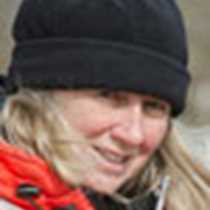Christiansø, Frederiksø and Bornholm, Denmark
Bornholmians, if that is what one can call a native of the island of Bornholm, describe themselves as being argumentative. And maybe that is good, for if they had not been so several hundred years ago, our destinations for the day might have offered quite a different scene. Christiansø might still be a vacant rock inhabited by a duck or two. And Bornholm might be flying quite a different flag. As it is, they spoke out proudly, expelled the Swedes and the Germans too and thus remain as Danish soil, unique and filled with life.
The full moon wore a wispy veil and danced in a rainbow ring as it followed us past the northern tip of Bornholm Island. Meanwhile the sun was fighting its own battle with the clouds, painting them delicate pink and blue until it finally won and cast itself into the sky ahead, illuminating two tiny, rounded, rocky islets with scattered skerries surrounding them. As Zodiacs zoomed to shore through wind-stirred seas, grey seals popped their aquiline heads above the surface in curiosity. From ramparts far above cannon stood guard, their only action a two-hundred-year-old memory.
Christiansø and Frederiksø embraced a tiny harbor into which we dipped to carry our explorations onto shore. The sound of hammers busy with repairs whisked our minds back more than three hundred years when chisels and picks and heavy sledge hammers were hewing massive building blocks from pink granite bedrock and heaving them into place to build ramparts and walls and buildings to house an impressive military force. Today the walls remain but the inhabitants reside in peace, enjoying the beauty of their little paradise. Mustard-colored walls and red clay roofs or ripe cherry-colored houses sat among verdant greenery where songbirds flitted and chattered. We strolled or simply sat and looked far off, warmed by the late summer sun.
During lunch the ship slipped south and east to the town of Svaneke on Bornholm’s eastern shoulder. Venturing from the coast where the most prevalent architectural feature seemed to be strange broad-based chimneys for smoking fish, we discovered the archetypical pastoral scene. Cattle grazed in open fields. Rows of straw awaited bailing into huge round mounds and corn tassels blew in the breeze. Round churches seemed to invite a variety of interpretations. Why were they really built?
Tree plantations from long ago had evolved into more natural-looking forests that beckoned some of us to explore. Trails ran along the cliffs of the northern tip of the island where heather cast a purple haze and fern fronds glistened in the light. High above the sea the ruins of a castle loomed, showing evidence of many stages of construction. Some of us entered by the main gate while others attacked from the sea but all ended up within the walls and crumbling foundations. After all these explorations, appetites were satisfied with a beer and herring snack before returning to the ship and setting out for our next destination.




